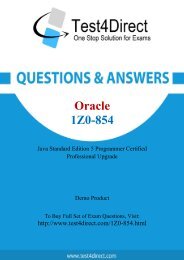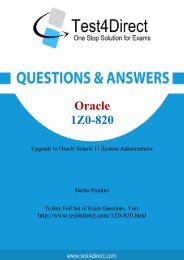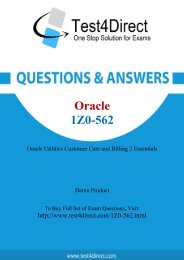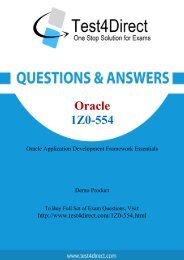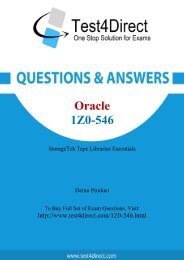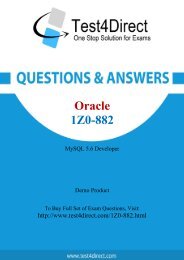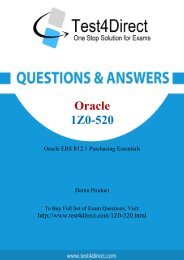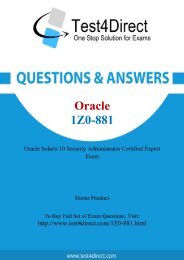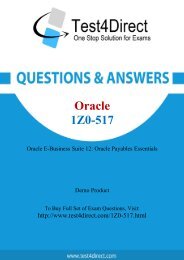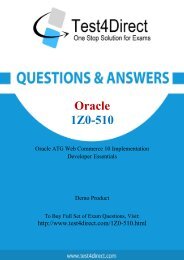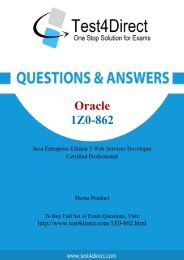Up-to-Date 1Z0-574 Exam BrainDumps
Test4Direct provides latest PDF questions of Oracle 1Z0-574 exam. You have an opportunity to pass the Oracle 1Z0-574 exam in one go. Test4Direct is most accurate source to prepare Oracle 1Z0-574 exam as your success will become site’s responsibility after purchasing 1Z0-574 exam product. There are also lots of discounts and promotion offers that you can avail. Let’s try a free demo http://www.test4direct.com/1Z0-574.html
Test4Direct provides latest PDF questions of Oracle 1Z0-574 exam. You have an opportunity to pass the Oracle 1Z0-574 exam in one go. Test4Direct is most accurate source to prepare Oracle 1Z0-574 exam as your success will become site’s responsibility after purchasing 1Z0-574 exam product. There are also lots of discounts and promotion offers that you can avail. Let’s try a free demo http://www.test4direct.com/1Z0-574.html
Create successful ePaper yourself
Turn your PDF publications into a flip-book with our unique Google optimized e-Paper software.
Grid computing operates on these technology principles:<br />
* Standardization.<br />
* Virtualization.<br />
* Au<strong>to</strong>mation.<br />
Reference: Oracle Grid Computing, White Paper<br />
Question: 10<br />
Which of the following statements are true about an end-<strong>to</strong>-end security strategy?<br />
A. End-<strong>to</strong>-end security and point-<strong>to</strong>-point security are virtually identical strategies proposed by<br />
different security vendors.<br />
B. End-<strong>to</strong>-end security strives <strong>to</strong> protect data at rest, even in temporary queues.<br />
C. End-<strong>to</strong>-end security often involves some form of message-level protection.<br />
D. When end-<strong>to</strong>-end security is enabled. Point-<strong>to</strong>-point transport-level encryption should be disabled<br />
in order <strong>to</strong> avoid cryp<strong>to</strong>graphy conflicts between layers.<br />
E. End <strong>to</strong>-end security is highly beneficial for distributed computing environments where many pointpoint<br />
connections and intermediaries exist, because it offers seamless data protection.<br />
Question: 11<br />
Answer: B,C,E<br />
Explanation:<br />
B:End <strong>to</strong> end security is an information-centric perspective of security where information is<br />
protected throughout the entire computing environment. That is, from<br />
the points where system interactions originate, through all points of integration, processing, and<br />
persistence.<br />
End <strong>to</strong> end security is often associated with the secure transmission, processing, and s<strong>to</strong>rage of data,<br />
where at no time are data unprotected<br />
Note:<br />
For a typical web-based application, end <strong>to</strong> end security generally begins at the client/browser, and<br />
ends at the application database and all external dependencies of the application.<br />
A common challenge in providing end <strong>to</strong> end security is finding a suitable way <strong>to</strong> secure data in all<br />
states and points along the processing path that does not interfere with any transmission, routing,<br />
processing, and s<strong>to</strong>rage functions that need <strong>to</strong> occur along the way. Sensitive data will usually need<br />
<strong>to</strong> be decrypted at certain points in order for processing or message routing <strong>to</strong> occur.<br />
Conceptually, the ORA model of a "modern UI" defines which three layers from the following list?<br />
A. Unified User Interface layer provides the control and visual elements that define the interaction<br />
that the user has with the system.<br />
B. Integration layer provides connec<strong>to</strong>rs <strong>to</strong> simplify and standardize Interaction with back-end -terns.<br />
C. Device Management layer provides transformation and transcoding <strong>to</strong> support a wide variety of<br />
devices.<br />
D. Browser Mediation layer adapts output <strong>to</strong> conform <strong>to</strong> the standards and capabilities of each<br />
browser type.<br />
E. User Interface Services layer provides reusable functions specialized <strong>to</strong> the needs of the end<br />
F. Access and Incorporation layer provides the capability <strong>to</strong> Incorporate data and functionality from<br />
any number of back-end systems in<strong>to</strong> the user interface.






